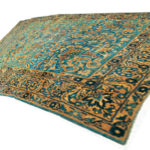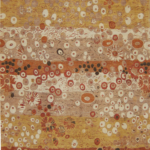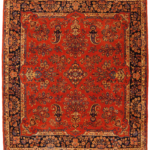Prendo in prestito dalla bacheca di Barry O’Connell questa interessante discussione con Jack Williams
PostJack Williams
Afshar – Re: Salor-Ersari-Seljuk. I have a lot of unorganized research on Afshar use of Armanian-like crosses in their rugs. This is consistant for Afshar groups isolated from each other for 400 years and 800 miles of desert. The Afshar are a Turk tribe that accompanied the Seljuks in their second wave miagration into Anatolia and the Caucasus. I speculate the common appearance of crosses dates from their proximity to the Armanians prior to the Afshar diaspora. The Afshar core and basic symbol however is the stepped cross polygon … often with “flames,” which is possibly Budhist origin, making that symbol one of the oldest in Turk rug design. Of note, Jerry Anderson avowed a relationship between the Afshar and the Ersari in the 1970s.
Afshar – Re: Salor-Ersari-Seljuk. I have a lot of unorganized research on Afshar use of Armanian-like crosses in their rugs. This is consistant for Afshar groups isolated from each other for 400 years and 800 miles of desert. The Afshar are a Turk tribe that accompanied the Seljuks in their second wave miagration into Anatolia and the Caucasus. I speculate the common appearance of crosses dates from their proximity to the Armanians prior to the Afshar diaspora. The Afshar core and basic symbol however is the stepped cross polygon … often with “flames,” which is possibly Budhist origin, making that symbol one of the oldest in Turk rug design. Of note, Jerry Anderson avowed a relationship between the Afshar and the Ersari in the 1970s.
Hello Jack,
Not disagreeing with you. Let me throw out some thoughts that I have been putting together for years.
Afshar are found in Turkey, North of Bijar, Kerman, Khorasan, and east of Shiraz which ties into the Kerman Afshar.
As for the T…urkey based Afshar, I assume that they either predate the Afshar or came in the 19th century from the Caucasus. I tend to think they are pre-Safavid.
As for the Persian Afshar I think Reid wrote that they were a troublesome tribe that attempted a revolt in either the reign of Shah Tahmasp or Abbas the Great. I think it was Abbas who put some in Khorasan in the north east of Ghoochan as a buttress against the Turkmen.
I believe that a significant body of Afshar was in the Georgia, Lori Pambak, and Erivan area until the Russians moved in from 1805 to when Erivan fell in 1828. I think Shekli Kazak rugs were Afshar.
I think Afshar area people who speak a dialect called Afshar and guys like Steve Price who think Afshar can be Kurds or the reverse are missing the point. I also believe that many people who are Afshar in the linguistic sense would never identify themselves as Afshar.
So I will reread your post over night and see how it squares with what I think and what I know. I am realistic enough to realize hat knowing and thinking are not he same thing.
Thanks for the post.
Barry
Not disagreeing with you. Let me throw out some thoughts that I have been putting together for years.
Afshar are found in Turkey, North of Bijar, Kerman, Khorasan, and east of Shiraz which ties into the Kerman Afshar.
As for the T…urkey based Afshar, I assume that they either predate the Afshar or came in the 19th century from the Caucasus. I tend to think they are pre-Safavid.
As for the Persian Afshar I think Reid wrote that they were a troublesome tribe that attempted a revolt in either the reign of Shah Tahmasp or Abbas the Great. I think it was Abbas who put some in Khorasan in the north east of Ghoochan as a buttress against the Turkmen.
I believe that a significant body of Afshar was in the Georgia, Lori Pambak, and Erivan area until the Russians moved in from 1805 to when Erivan fell in 1828. I think Shekli Kazak rugs were Afshar.
I think Afshar area people who speak a dialect called Afshar and guys like Steve Price who think Afshar can be Kurds or the reverse are missing the point. I also believe that many people who are Afshar in the linguistic sense would never identify themselves as Afshar.
So I will reread your post over night and see how it squares with what I think and what I know. I am realistic enough to realize hat knowing and thinking are not he same thing.
Thanks for the post.
Barry
Let us say that you are right on the Afshar Armenian idea. The Afshar were in the Caucasus prior to 1508. The Oguz Seljuk Afshar supported the Turkmen Dynasty and the Safavid split the Afshar with the Afshar becoming one of the Kizilbash tr…ibes. Both were in what is now Armenia and both were in close proximity to Armenians. One thing to consider is that the Turkmen tribes absorbed people whenever they were in the ascendency so it is possible and possibly even likely that Armenians were converted into Islam and absorbed into the Afshar. I cannot say for sure but it is possible. As I think through it I believe that the Persian Afshar are Shia. I wonder if the Turkish Afshar are Sunni. If so then I bet that split went back to the Turkmen Afshar Kizilbash Afshar split. Both branches could carry vestiges of the Armenians.
As for Jerry Anderson I have some real problems with a lot of his theories but Afshar and Ersari are both related. The Oguz split over Islam. The Ersari and the Seljuk was the same tribe and the Seljuk adopted Islam first and the remnant who converted later was the Ersari who stayed in Turkestan and joined the Salor Confederation. The Afshar adopted Islam with the Seljuk and moved first into Khorasan and then west.
Best wishes,
Barry
You are very right directionally. The Afshar of Duraquez on the Turkmenistan border were moved by Shah Tahmisp, not Abbas, separately from the Abbas exile of Afshar to Kerman. The Afshar around Bijar were moved still later to replace Kurd…s who had rebelled, and then were exiled to Kurrison. That Afhsar community still exists and uneasy relationships with the Kurds has lasted 300 years … some Bijar carpets are unmistakenly Afhsar. Lastly, there are remenant Afhar groups in the Caucasus as well.
But the most well known community is of course Kerman area. Much is wrong with what has been written about that community, especially weaving. Unlike the other Afshar groups, the Kermanis were almost completly isolated from other weaving communities, and that isolation acted as a preservative for the oldest designs.
Contray to Eiland, they didn’t “adopt” persian designs because when they arrived the country was unpopulated and weaving didn’t seriously start in Kerman itself until 200 years later. Phyogenisis of the Afshar is pretty strong. And their core designs are tracable back to the Caucasus… and possibly back to E. Turkistan, in my opinion.
Regards
giovedì alle 5.07
Note: the Afshar moved to the Bijar area after the local rebellious Kurds were sent to Kurrison. They were intended to be a Turkish check on the Kurd population… and the hosstility between the Kurds and Turkmen was a long time feeling. …The Afshar Emirs ended up also controlling a lot of the Chahar Mahal area… later populated by exiled Armanians. True the Afshar passed through Kurrison on their initial movement with the Seljuks.. but “tribes” of that era were just interrelated family groups..average population of a “tribe” might be about 50,000 people max.
The split along the Turk-sunni, Azer-shia was pretty complete. Salim the grim pretty much killed every shia turk on the Turk side of the line. The Afshar were almost completely Shia… and the Shia-turks of Afghanistan today are all called “Afshar.”giovedì alle 5.16
Jack Williams Re: Jerry – yes he had some wild ideas…and would ramble on into the blue (according to my brother who knew him well) But amazingly, some of his most blue-sky statements have been shown to have a strong basis. He was a most well-read, intellectually powerful, but completely ADD man. It was a real loss that no one ever forced him to write his book.
giovedì alle 5.19
Jack Williams I think there is a strong possiblity of a residual connection with Afshar rug design and “Genji” weavings in the Caucasus… the Genfi stripe appears in Afshar rugs ubiquitously. The connection is a little tenuous, but it is there every time I see “Genji” rugs…which of course in the Kazak family… so you may be definitly on the same track as I am.
Barry O’Connell The more I think the more comfortable with what you are proposing. As for your rug is seems related to the Sheckli Kazaks. I remember Harold Keshishian describing the handle of a Shekli as leathery. what is yours like
giovedì alle 5.30
Jack Williams Incidentally, that rug of mine has symetric knots. Contrary to Edwards, this is not very common in Afshar rugs…most older examples have asymetric open right. I don’t know why Edwards got the weave (he said single weft) and knot wrong about the Afshar when he was able to distinquish individual village products… but he also got techniques of the Baluch wrong. Strange.
giovedì alle 5.31
Barry O’Connell Edwards was OCM. What OCM sold he knew well. OCM did not do much with Afshar and Baluch so he had less exposure. Edwards took over Baker Bros. (his uncles) the Turkish rug company until the massacres. Then it became a Persian based company until its focus shifted to India. If OCM was as great as Edwards indicated in The Persian Carpet how come we almost never see either Baker Bros or OCM rugs at auction and when we do they are rather mediocre.
Jack Williams ”Handle” is something I’ve never gotten a handle on LOL. It certainly isn’t floppy, maybe “newbluejeany.” My brother has an actual leather rug made in the southern deserts of Pakistan, and a rare item… thinking about it.. maybe “softleathery” isn’t bad. Incidentally, I think that rug may be Duraguez (extreme northern Persia-Khurrison) origin, possibly chochinal red, at least the coloring looks like it.
giovedì alle 5.45
Jack Williams I also suspect a connection between the “Baluch” Bha’luli and the Afshar. The folk history of the Bha’luli matches the lore of the Duraquez Afshar suspeciously closely… they also use symetric knots and their designs have an echo, often a strong echo.
giovedì alle 5.56
Barry O’Connell I just keep adding notes in hope of piecing them together. Here is a link to my notes on Duraguez:
giovedì alle 5.56
Jack Williams I believe Edwards did get a lot of the social history correctly recorded. Whether it is strictly accurate is another question.. but from a social and ethnographic standpoint, his book might be more valuable than the rug commentary… given his interest in commercial carpet-sized weavings.
giovedì alle 5.58
Barry O’Connell I love Edwards and the Persian Carpet. It is just that some guys equate it to the Canon of Scripture. It is certainly not infallible
giovedì alle 6.04
Jack Williams I concur… same goes for Dr. Eiland. Lots of great stuff, but some of his published information seems to be just from the rug bazar lore, and from … Edwards. He is domnstratably wrong about much Baluch and his offhand (erroneous) comments on the Afshar threw a red herring across that trail for much of rugdom research, in my opinon
giovedì alle 6.04
One of the most prominent people in Oriental Rugs recently wrote to me and mentioned that he was using my sites in his research. He then said hat my rug notes are “generally accurate”. I take that as a compliment but I wish he would tell me… what he disagrees with. When I proof read Emmett Eiland’s book we disagreed on 18 points. So we worked out and some we agreed to disagree on. But at least he knew. I can imagine that it would have been difficult for Edwards or Murray Eiland to get a good proof reader. I know I could use one. Sometimes I grown when I see some mistakes I have made. Then again there are times when everybody thinks I am wrong but I am sure I am right.
giovedì alle 6.24
Barry, the issues that come up about rugs are anthropolical and ethnographic. Rugs are just the “clay pots”, artifacts, used to shed light on the unrecorded tribal people’s history. If we just were interested in rugs, to heck with who whe…re what when how. But that is not human. Look at a painting and you will want to know who did it, when, what materals. The problems with “rug research” is that it is done by people interested in rugs and tainted by the ubiquitous commercial overtones, not people trained and interested in professional historical ethnography. That’s where we come in… regards
giovedì alle 6.34
One more thing. The central point of my thesis is the existence of a core Afshar peoples symbol… the stepped polygon cross, most often with “flames.” Of all the “tribal” groups, the Turkmen as a people are the most perfect cultural exam…ple of phylogenisis as a controlling ethic. Their culture almost always rejected outside influence, even to marraige. While knotting changed according to what slaves were doing the work, their designs for their main carpets were dogmatically consistent. (Smaller bags and women’s articles allowed more freedom of expression)… but that Afshar stepped polygon cross is in all Afshar weavings even as the group dispersed, and fragmented. This of course is a thesis…. but with considerable backup. Just wanted to underline that point. Regards.
23 ore fa
Jack Williams
Related posts
Articoli in evidenza
Categorie
- ARTE E MOSTRE
- KILIM
- TAPPETI AFGANI
- TAPPETI AGRA
- TAPPETI ANTICHI
- TAPPETI BHADOHI
- TAPPETI CAUCASICI
- TAPPETI CINESI
- TAPPETI CLASSICI
- TAPPETI DESIGN
- TAPPETI HYDERABAD
- TAPPETI INDIANI
- TAPPETI KAZAK
- TAPPETI MODERNI E CONTEMPORANEI
- TAPPETI PATCHWORK E RELOADED
- TAPPETI PERSIANI
- TAPPETI PESHAWAR
- TAPPETI RIVER E SAMSUNG
- TAPPETI SHIRVAN
- TAPPETI TABRIZ
- TAPPETI TIBET
- TAPPETI TURCHI E ANATOLICI
- TAPPETI TURCOMANNI E TURKMENISTAN
- TAPPETI ZIGLER E ZIEGLER
- UNCATEGORIZED
- VARI







